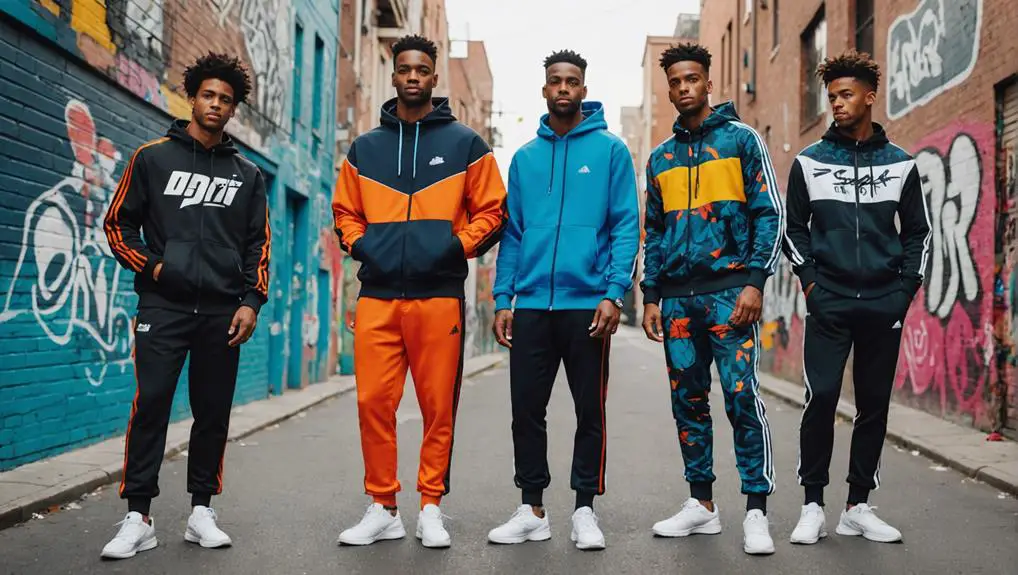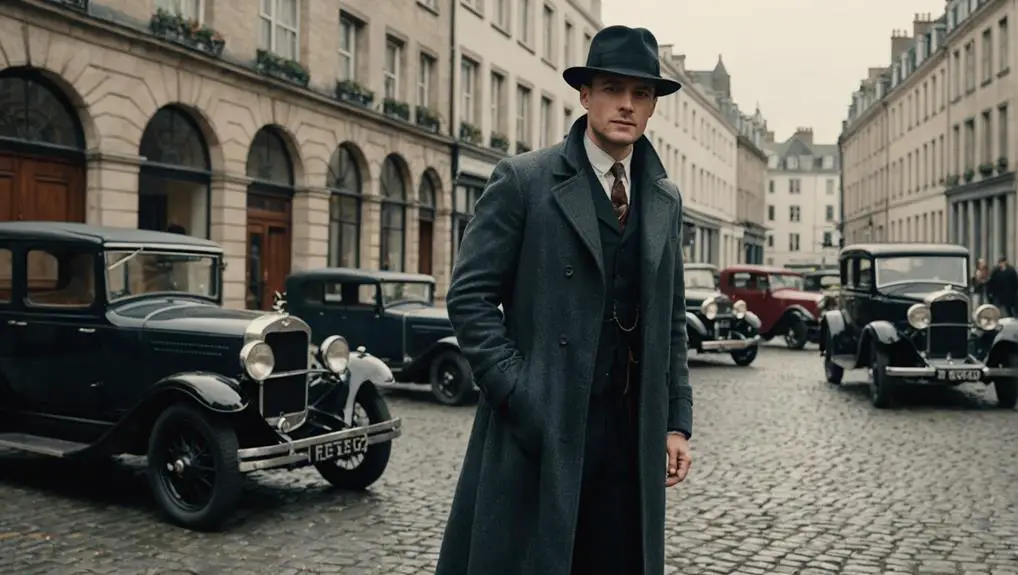In the 2010s, men's tracksuits exploded in popularity, transforming from mere workout gear into street style must-haves. You'd find bold colors and unique patterns dominating the scene, with celebrities like Kanye West and LeBron James pushing tracksuits into high fashion. The athleisure trend made them versatile, perfect for both casual outings and upscale events. Iconic collaborations with brands like Adidas and Gucci elevated tracksuits to luxury status, blurring the lines between comfort and chic. As they became symbols of relaxed confidence, you'll see how the tracksuit's evolution reflects wider fashion trends of the decade. There's so much more to explore!
Evolution of Tracksuits
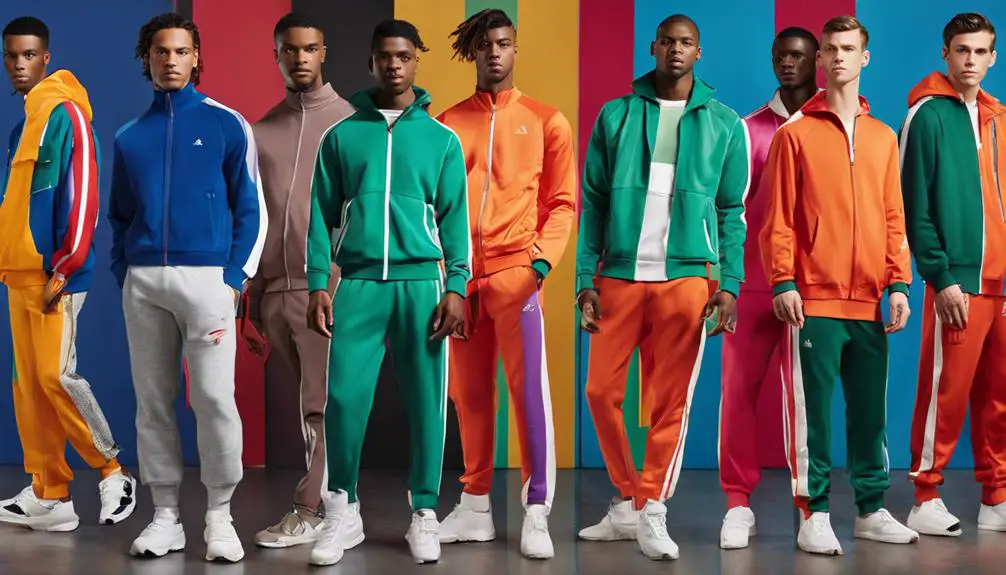
The evolution of tracksuits in the 2010s marked a significant shift from purely athletic gear to a staple of fashionable streetwear. No longer confined to the gym, tracksuits became a versatile option for casual outings, embodying the athleisure trend that took over the decade. You'll notice how high fashion and streetwear collided, with designer collaborations, like Adidas and Kanye West's Yeezy, turning tracksuits into luxury items that blended comfort with style.
As you explore this trend, you'll see tracksuits donning bold colors, unique patterns, and oversized fits, reflecting a broader movement towards personal expression. Influencers and celebrities prominently showcased tracksuits in their everyday looks, pushing them into the mainstream and making them a must-have in your wardrobe. These pieces aren't just for running errands; they've transformed into a fashion statement that conveys effortless chic.
Whether you're heading to brunch or just lounging at home, tracksuits now offer that perfect balance of relaxed yet trendy. Embrace this evolution and elevate your streetwear game with tracksuits that keep you comfortable while ensuring you look stylish at the same time.
Cultural Impact on Fashion
Tracksuits have carved out a unique niche in the fashion landscape, seamlessly merging athleticism with everyday style. The rise of athleisure in the 2010s transformed tracksuits into must-have garments, blurring the lines between sporty and chic. Influenced by street culture and the hip-hop movement, you'll notice tracksuits embody a sense of comfort and trendiness, becoming staples for both celebrities and fashion icons.
Major brands seized this moment, launching collaborations that propelled tracksuits into high fashion. Their cultural significance is evident in music videos and social media, where influencers showcase diverse and stylish interpretations. As workplace dress codes relaxed, tracksuits gained acceptance even in more formal settings, reflecting a broader shift toward casual chic in men's fashion.
| Cultural Elements | Impact on Tracksuits |
|---|---|
| Street Culture | Became symbols of comfort |
| Hip-Hop Influence | Elevated style perception |
| Brand Collaborations | Merged high fashion with sport |
| Social Media Trends | Showcased diverse styles |
| Relaxed Dress Codes | Accepted in formal settings |
This evolution highlights how tracksuits have not only shaped but have also been shaped by a vibrant cultural landscape.
Celebrity Influence and Trends
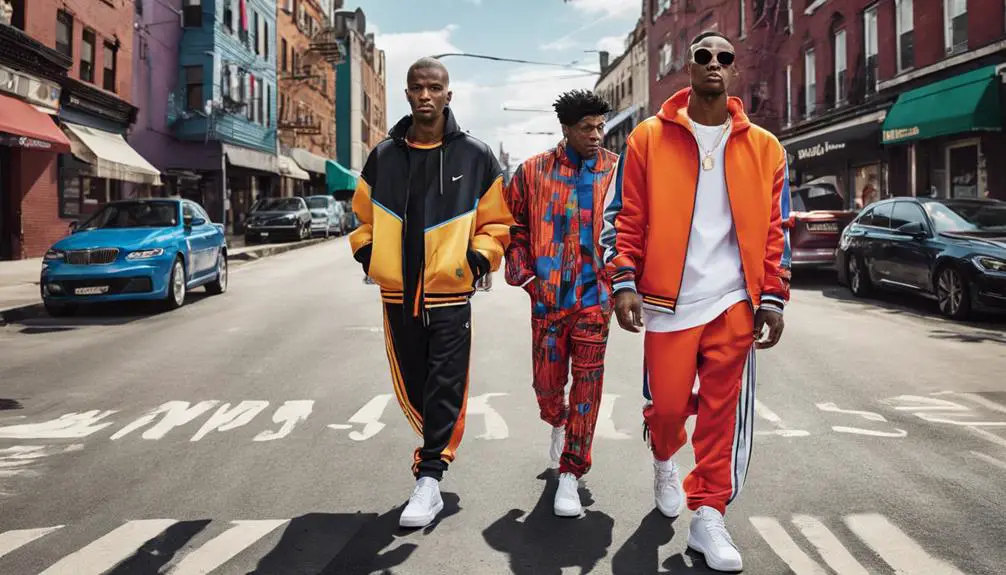
Throughout the 2010s, celebrity influence played a pivotal role in transforming tracksuits into fashion statements. You couldn't scroll through social media without spotting icons like Kanye West, who popularized minimalist tracksuits through his Yeezy line, showcasing neutral tones that redefined casual wear. Athletes like LeBron James and David Beckham didn't just wear tracksuits; they elevated them, merging comfort with style and pushing these pieces into the domain of high fashion.
The rise of athleisure brought tracksuits onto major fashion runways, proving they were more than just gym wear. Influencers on platforms like Instagram made tracksuits a staple in everyday wardrobes, driving their mainstream acceptance and desirability. You started seeing stylish variations everywhere, from sleek designs to bold prints, all thanks to the power of celebrity endorsement.
Collaborations between sportswear brands and high-fashion designers, such as Gucci's tracksuit line, highlighted this exciting merger of luxury and athletic aesthetics. As tracksuits shifted from the gym to the runway, they became an essential part of the modern man's wardrobe, embodying the spirit of versatility and style that defined the decade.
Tracksuits in Streetwear
As the lines between athletic wear and everyday fashion blurred, tracksuits emerged as a defining element of streetwear in the 2010s. You couldn't walk down a city street without spotting someone rocking a bold tracksuit, effortlessly combining comfort with style. These pieces reflected a unique blend of athletic and casual aesthetics that resonated deeply with urban culture.
High-profile collaborations, like Adidas teaming up with Kanye West's Yeezy line, propelled tracksuits to high-fashion status, making them a must-have in your wardrobe. The relaxed dress codes of the era allowed you to wear tracksuits in both casual and semi-formal settings, breaking away from their traditional athletic roots.
Iconic styles, including velour and nylon tracksuits, often featured eye-catching logos and vibrant color-blocking, cementing their place in streetwear culture. Influencers and celebrities showcased their tracksuit looks on social media, driving demand and solidifying these outfits as a fashion statement. With their versatility and appeal, tracksuits didn't just serve as workout gear; they became a symbol of a new era in streetwear, merging comfort with an undeniable sense of style.
Comfort Meets Style

Men's tracksuits redefined comfort in the 2010s, seamlessly blending functionality with flair. As athleisure took center stage, brands like Adidas and Nike began crafting tracksuits that were not only performance-driven but also stylish enough for streetwear. You could easily shift from a workout to a casual outing without missing a beat.
With their sleek designs and advanced fabric technology, these tracksuits became essential components of your wardrobe, enhancing your comfort while making a bold fashion statement. Celebrities and influencers showcased how to elevate a simple tracksuit by pairing it with high-fashion accessories, proving that comfort doesn't have to sacrifice style.
The trend of relaxed dress codes in workplaces made tracksuits even more appealing, highlighting their versatility. You could wear them for a coffee run, a gym session, or even a laid-back office meeting. Tracksuits featured bold colors, unique patterns, and collaborations with designers, allowing for personal expression in your style choices. In this era, comfort truly met style, and men embraced tracksuits as a symbol of modern fashion, effortlessly merging practicality with contemporary aesthetics.
Branding and Identity
The tracksuit transformed into a powerful emblem of casual chic in the 2010s, effortlessly blending athletic wear with everyday fashion. This shift towards athleisure revolutionized how you perceive comfort and style, allowing you to embrace tracksuits as more than just workout gear. Brands like Adidas and Nike led the charge, rebranding tracksuits with bold logos and vibrant colors, making them a stylish choice for both the gym and the streets.
As you navigate this era, you can't ignore the influence of luxury brands like Gucci and Balenciaga, which elevated the tracksuit from mere sportswear to a coveted status symbol. This branding shift dramatically reshaped the garment's identity, aligning it with modern masculinity and sophistication.
Social media and celebrity endorsements played a significant role in this transformation, as influencers and athletes showcased tracksuits as essential components of contemporary menswear. Their visibility reinforced the tracksuit's connection to a laid-back lifestyle while simultaneously marking a broader cultural shift towards relaxed attire in various social settings. In this world, the tracksuit isn't just clothing; it's a statement of identity, comfort, and a new definition of stylish living.
High Fashion Adaptations
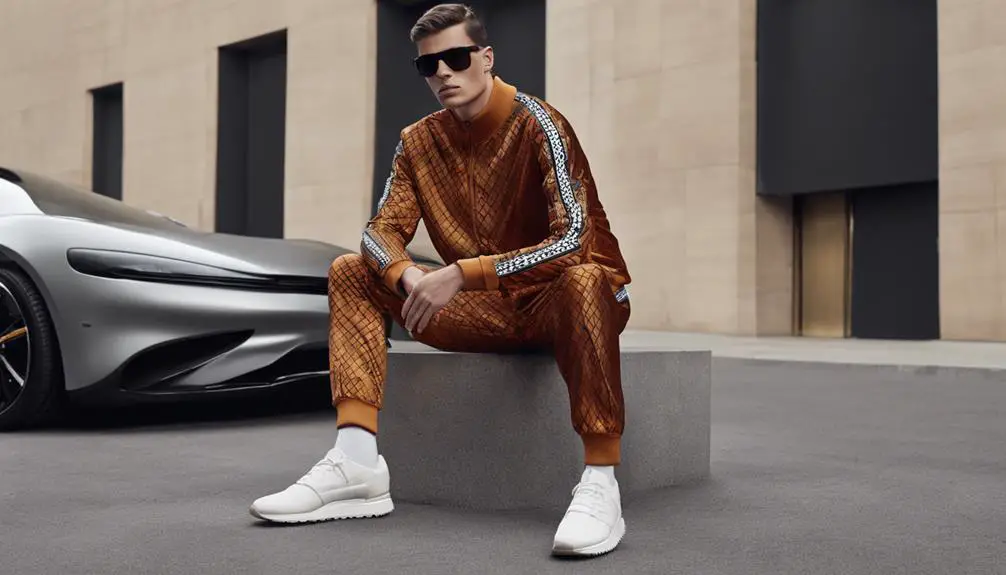
Tracksuits took a bold leap into high fashion during the 2010s, redefining their role in the wardrobe of style-conscious individuals. No longer just for the gym, these versatile pieces became essential in both casual and formal settings, thanks to the rise of athleisure. Luxury brands like Balenciaga and Gucci showcased tracksuits with bold designs and high-quality materials, making them a staple for fashion enthusiasts.
| Brand | Design Elements |
|---|---|
| Balenciaga | Innovative cuts, bold prints |
| Gucci | Luxurious fabrics, vibrant colors |
| Yeezy | Minimalist styles, muted tones |
| Off-White | Streetwear vibes, signature logos |
| Prada | Tailored fits, high-end materials |
Celebrity influence played a significant role, with stars like Rihanna and A$AP Rocky embracing luxe tracksuit ensembles, further legitimizing this trend. You can see how the unique textures and exclusivity of high-fashion tracksuits attracted fashion-forward consumers. As the lines between sportswear and everyday fashion blurred, you found yourself reaching for tracksuits not just for comfort, but as a statement of style.
Sustainability in Tracksuit Production
Sustainability's influence on tracksuit production has surged in the 2010s as brands recognize the need for eco-conscious practices. You've probably noticed the increasing availability of tracksuits made from eco-friendly materials like organic cotton and recycled polyester. These choices not only reduce the environmental impact of production but also align with your desire for responsible fashion.
Many manufacturers are now implementing transparent supply chains, ensuring sustainable sourcing and ethical labor practices. This reflects a growing consumer preference for brands that prioritize both style and sustainability. The athleisure trend has further encouraged brands to innovate, leading to moisture-wicking fabrics crafted from recycled materials—perfect for your active lifestyle.
Vintage and thrift shopping has also gained traction, allowing you to discover unique tracksuits from previous decades while promoting a circular fashion economy that minimizes waste. Plus, collaborative efforts between fashion brands and environmental organizations are raising awareness about the importance of sustainability in tracksuit production. By choosing sustainable options, you're not just upgrading your wardrobe; you're making a statement about the kind of world you want to support.
Key Brands and Collections
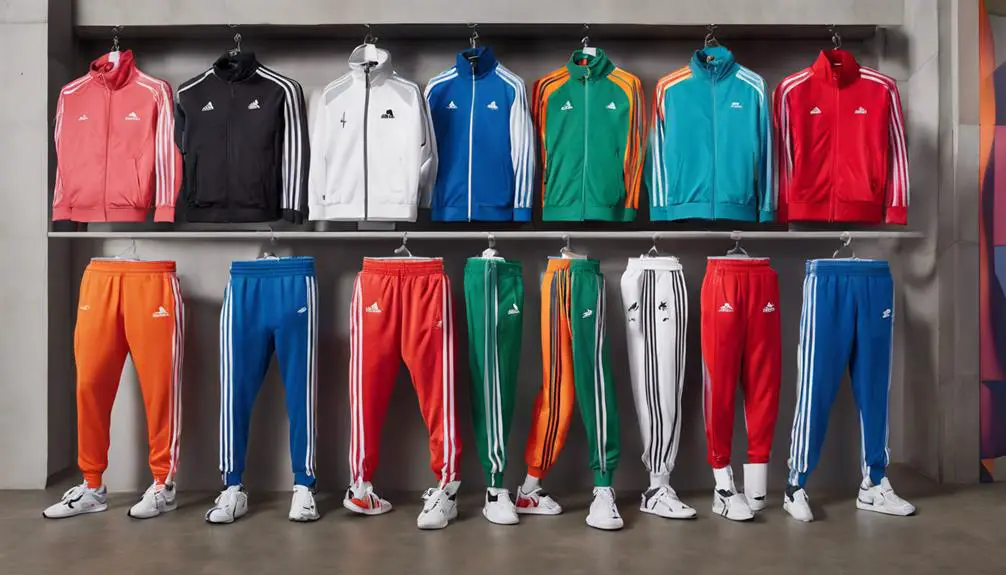
Throughout the 2010s, several key brands and collections transformed the tracksuit from a simple athletic garment into a fashion statement. Major players like Adidas, Nike, and Puma dominated the market, blending athletic functionality with streetwear aesthetics. The resurgence of the Adidas tracksuit, especially the iconic three-stripe design, became a staple in both casual and high-fashion wardrobes.
Nike's Tech Fleece collection gained popularity due to its innovative materials and sleek silhouettes, appealing to those who wanted comfort without sacrificing style. Meanwhile, luxury designers like Gucci and Balenciaga elevated tracksuits to high-status symbols in menswear, showcasing them on runways and in exclusive collections.
Collaborations between sportswear and fashion brands, such as Off-White and Nike, blurred the lines between athletic wear and luxury fashion, solidifying tracksuits as a key trend.
| Brand | Notable Collection |
|---|---|
| Adidas | Iconic Three-Stripe |
| Nike | Tech Fleece |
| Gucci | High-End Tracksuits |
| Off-White | Nike Collaboration |
This blend of luxury and athleticism defined the decade, making the tracksuit a must-have item for any fashion-conscious individual.
Future of Men's Tracksuits
As the fashion landscape evolves, the future of men's tracksuits promises an exciting blend of luxury and practicality. You'll likely see high fashion brands embracing tracksuit styles, transforming them into chic statements. Collaborations like Gucci x The North Face highlight this trend, merging athletic wear with upscale aesthetics.
Sustainability will drive innovation, as more brands commit to eco-friendly materials and ethical production methods. You can expect tracksuits made from recycled fabrics and organic cotton, catering to your desire for style without compromising the planet.
With remote work and athleisure remaining prevalent, tracksuits will continue to dominate casual attire, allowing you to effortlessly shift from lounging at home to running errands while looking sharp. Innovations in fabric technology, like moisture-wicking and temperature-regulating materials, will enhance comfort and functionality for various occasions.
Streetwear culture will further influence tracksuit designs, bringing bold colors, unique patterns, and eye-catching embellishments into the mix. As a younger consumer, you'll find standout pieces that express your individuality while keeping you comfortable. The future of men's tracksuits is bright, blending luxury, sustainability, and streetwear into your everyday wardrobe.
Frequently Asked Questions
What Did Guys Wear in the 2010s?
In the 2010s, you wore relaxed fits, vibrant colors, and trendy sneakers. Athleisure ruled your wardrobe, blending comfort with style, while oversized tees and joggers made casual outings feel effortlessly chic and fashion-forward.
When Were Mens Tracksuits Popular?
Men's tracksuits really took off around the 2010s, blending comfort with style. You'd see them everywhere, from casual hangouts to fashion runways, making them a versatile staple in your streetwear wardrobe.
What Were the Popular Clothing Stores in the 2010s?
In the 2010s, you'd find trendy styles at H&M and Zara, while Nike and Adidas ruled athleisure. High-end brands like Gucci influenced streetwear, and online retailers like ASOS catered to your fashion cravings effortlessly.
Were Tracksuits Popular in the 2000s?
Yes, tracksuits were incredibly popular in the 2000s. You'd see them everywhere, from gym sessions to street style. Bold colors and unique patterns made them a go-to choice for comfort and fashion.
